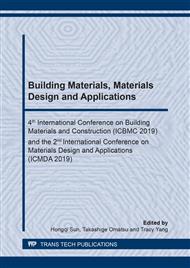p.3
p.10
p.16
p.26
p.34
p.40
p.50
p.57
p.64
Bond Behavior of Low-Activated High Aluminate Concrete with Reinforcement under Cyclic Load
Abstract:
The bond behavior of reinforcement and low-activated concrete (LAC) was investigated in this study. The acoustic emission monitoring was also engaged while the specimen being loaded to figure out the inside fracture. Static loading and dynamic loading were applied for both of the LAC and normal concrete in the pull-out tests. The upper load was applied starting from 30% of the static ultimate load Pu with a 10% increment until the failure. The loading frequencies for the test were 0.5 Hz、1.0 Hz and 2.0 Hz. The bond stiffness after each stage of dynamical loads was examined. Test results reveal that the LAC performs higher compressive strength than normal concrete for a given W/C ratio. But, the bond strength of LAC seems not promotes correspondingly. It may be attributed to the conversion effect of high alumina contained in LAC, which leads to more voids inside the concrete.
Info:
Periodical:
Pages:
34-39
Citation:
Online since:
October 2019
Authors:
Keywords:
Price:
Сopyright:
© 2019 Trans Tech Publications Ltd. All Rights Reserved
Share:
Citation:


